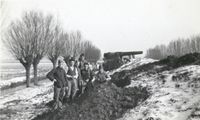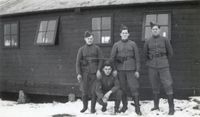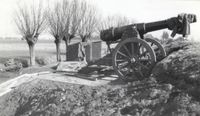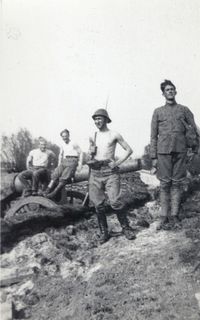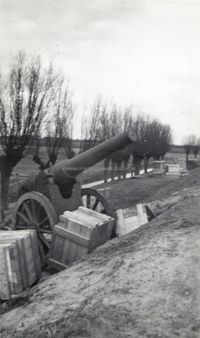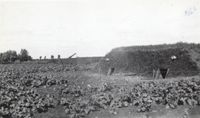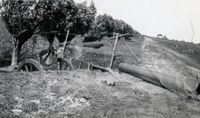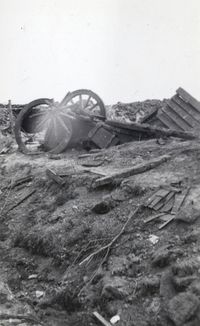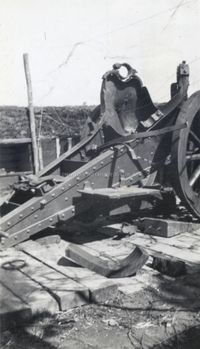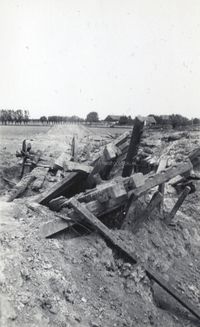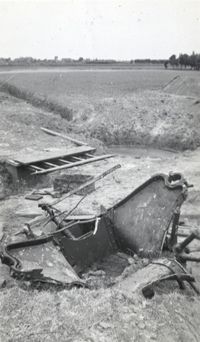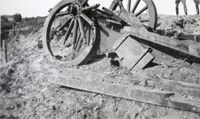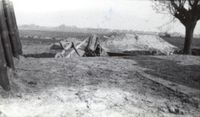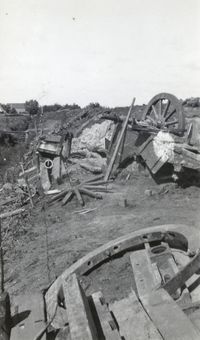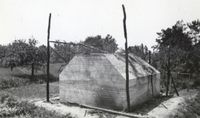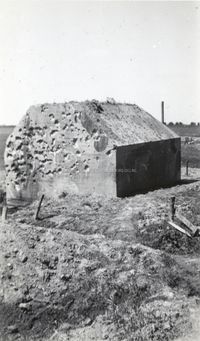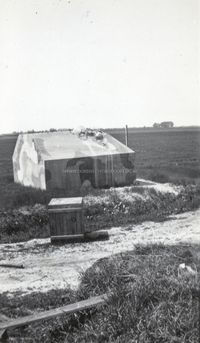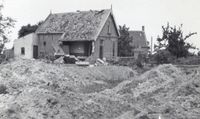Photoalbum May 1940 - Ensign N de Braal.
Here are the photos from the photo album of Ensign N. de Braal. Ensign de Braal was part of the 25th Department Artillery (25 AA) during the mobilization period and May 1940 in the Hoeksche Waard, on the opposite side of the Dordtse Kil. He was the commander of the 2nd battery. Many of the photos were taken during the mobilization in the winter of 1939-1940 and during the events in May 1940. The album offers a unique perspective on an Artillery Battery during the mobilization period.
The 25th Artillery Department was part of the Kil Group and had been present within the South Front since December 1939. The unit consisted of three batteries, each equipped with four heavily outdated 15 lang 24 (15 long steel) cannons dating back to 1880. The fact that the cannons were so old was due to the lack of artillery units within the Dutch army during mobilization period. The caliber of the fired shells was 150 mm. The height of the cannons was approximately 3 meters, and weighing 4700 kg, they were cumbersome artillery pieces that were not easily positioned. This had consequences for the firing capacity, as the cannons could not be easily rotated. The firing range was therefore limited to fixed, predetermined directions. The cannons required a recoil bed and were positioned in prepared sites along the reinforced dikes with wooden platforms and screens. Blast-proof shelters were also constructed alongside the positions. The unit was stationed along the east side of the Hoeksche Waard near 's Gravendeel, close to the Schenkeldijk. The 1st battery was located at Hoeve ( farm ) van den Berg, the 2nd battery at Meerkoot, and the 3rd battery at De Wacht. The prepared firing direction for the unit was the central part of the Moerdijk bridgehead. The overall commanding officer of the 25th Artillery Unit was Reserve Captain E. Cohen. Twelve additional 12 lang steel cannons were stored as reserves in Strijen. *1 *2 *3.
The 25 AA in May 1940.
As mentioned earlier, the second battery of the 25th Artillery Department was under the command of Ensign N de Braal. On May 10, 1940, around 4 o'clock in the morning, the unit's soldiers were awakened when German planes bombed positions near Moerdijk and Willemdorp. Despite the preparations that had been made, camouflage nets still needed to be applied, and telephone connections had yet to be established. Around 6:15 in the morning, the second battery fired its first shots towards Lage Zwaluwe. A short while later, around 8:25 am, a second volley was fired at Willemsdorp. During this barrage, one of the cannons in the third battery exploded, with the rear part flying about 20 meters into the field, fortunately without any casualties. Throughout the day, several more barrages were fired, alternating with periods of ceasefire during the night. Some cannons had to be taken out of service due to malfunctions. The following day, on May 11, several cannons remained permanently out of service, reducing the unit to only two functioning batteries. As the day progressed, more cannons became inoperable due to malfunctions, further reducing the unit's strength. Firing had to be continually interrupted for repairs to be made on the cannons. Nevertheless, the unit continued to deliver significant artillery fire. In the afternoon, the Luftwaffe conducted a bombing raid on the positions. The soldiers of the 2nd battery took cover at the battery's command post. There was minimal damage, with only one cannon from the left (3rd) battery being taken out, and there were no casualties. On May 12, the left battery was bombed by aircraft. By Monday, May 13, most batteries had very few functional cannons left. The presence of enemy aircraft had diminished, but now the unit was also facing German artillery fire. Additionally, fatigue had set in, with some soldiers falling asleep next to the cannons despite the ongoing firing. Soldiers of the second battery under Ensign de Braal witnessed the tanks and other vehicles of the German 9th Armored Division crossing the Moerdijk Bridge and continued to engage them with fire. Meanwhile, two more cannons in the 2nd battery had also become inoperable. When the infantry of the 28th infantry regiment evacuated the Kil shore and contact with the artillery group's command post could no longer be established, it was decided to withdraw to Strijen. Six out of the twelve cannons of the 25th Artillery Unit had already been rendered inoperable due to enemy fire or malfunctions. The remaining cannons were also disabled. Between May 10 and 13, over 2,500 rounds were fired by the 25th Artillery Department, targeting objectives within the Moerdijk bridgehead, Willemsdorp, and the island of Dordrecht. 4 *5 *6
Schematic drawing of the positions of the 25th AA unit.
This drawing is from the combat report: 487020 Report of the 3rd piece of the 2nd battery of the 25th artillery department by Sergeant G. Vaheul.
©2017-2024 :Https://www.Dordrechtindeoorlog.nl: ( There is a copyright on the content of this website. This content is not to be shared, duplicated or published withouth the explicit permission of the author of this website. If you have any requests you can email to: Info@Dordrechtindeoorlog.nl or look on : www.dordrechtindeoorlog.nl/termsofuseforthecontentonthiswebsite.
Sources:
*1 Source: Zuidfront-Holland1940 - Proloog - Artillerieopstellingen.
*2 Source: Zuidfront-Holland1940 - Proloog - september 1939.
*3 Source:Zuidfront-Holland1940 - Proloog - Groep Kil Hoeksche Waard.
*4 Source: Zuidfront-Holland1940 - 10 mei Groep Kil.
*5 Source:Zuidfront-Holland1940 - 11 mei Groep Kil.
*6 Source:409 Archieven - Pak K. XI Zuidfront Vesting Holland - Groep Kil - Artillerie in de groep Kil.



